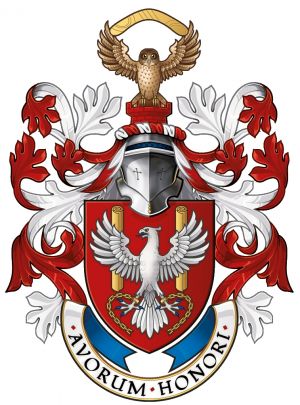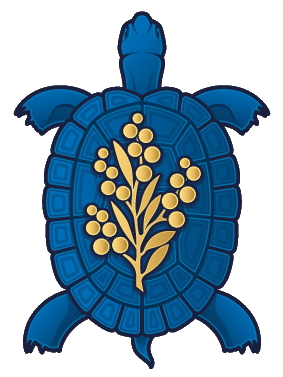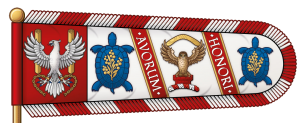George William Helon
| Heraldry of the World Personal arms |
GEORGE WILLIAM Esq.
Registration no.: 007/2021
Individual/family : Individual
Country of origin : United Kingdom
Place of origin : Toowoomba, Queensland, Australia
Granted : Yes
Granted/officially recorded by : College of Arms
Official English blazon
Arms: Gules an Eagle displayed Argent attached to each foot by a Manacle a broken Chain the Wings surmounting on either side a Scroll palewise Or.
Crest: Upon a Helm with a Wreath Argent and Gules Perched on the top of a Tower Gules a Rufous Owl affronty displayed proper supporting with the Wing Tips a Boomerang Or.
Mantling: Gules doubled Argent.
Badge: A Turtle palewise Azure charged on the Shell with a Sprig of Golden Wattle Or.
Motto: AVORUM HONORI (‘For the Honour of Our Ancestors’).
Standard: As rendered per Letters Patent - Arms, Badge, Crest, Badge
Other language blazon
Origin/meaning
Escutcheon (Shield): A red field symbolic of nobility, generosity, military strength, the warrior and martyrdom – sacrifice; indicative of the primary colour of the coat of arms of Poland where generations of the armiger's family lived before they were arbitrarily arrested and deported to Siberia at gunpoint by the dreaded Soviet NKVD during the early hours of the morning of Saturday 10 Februay 1940.
Eagle: The white eagle (rendiscent of the Polish Orzeł Biały) is depicted with its wings and legs outstretched, its head turned to the right, in a pose known in heraldry as ‘displayed’ which is representative of speed and wisdom. The eagle’s plumage, as well as its leg scales are white with gradient shading suggestive of a bas-relief – a solid and powerful sculpture. In homage to the armiger's Polish ancestry, symbolic of nobility, grace, power, courage, freedom and fortitude of mind.
A symbol of hope, of strength and of resurrection; the latter is based on the early belief that the eagle, unlike other birds, periodically renewed its plumage and its youth by flying near the sun then plunging into the water.
Manacles: Although originally indicative of bondage, slavery and servitude, manacles have come to signify victory, salvation, redemption and resurrection.
Attached to each foot of the eagle is a manacle with a broken chain symbolic of the freedom of the armiger's parents and their families from the bondage and suffering their families endured during, and after World War II.
Chains: Symbolic of captivity and servitude. Being broken, the chains are indicative of ‘freedom’ from persecution and oppression, exile to the inhospitable wastelands of Siberia and forced slave labour at the hands of the Soviet NKVD Secret Police.
Scrolls: The first form of editable record keeping texts, used in Eastern Mediterranean and ancient Egyptian civilizations were scrolls.
Whilst one of the scrolls alludes to Judaism and the Torah – scholarship, the Hebraic roots of the Helon family (as well as to the armiger's work as an author, historian and genealogist), the other scroll is a reference to their appointment as a Justice of the Peace (Qualified) for the State of Queensland; for Justices of the Peace undertake many important administrative and legal functions.
THE CREST
Boomerang: Aloft the owl supports a gold boomerang at the tips of its out-stretched wings. Knowledge is as valuable, if not more so than gold, but unlike gold that is heavy to lift, knowledge is weightless, yet powerful and potent, words as light as air but as heavy as a hammer; what goes around, comes around!
Owl: The Rufus Owl (indigenous to Eastern Queensland), recognises the esteemed tribute bestowed upon me by Aboriginal Tribal Elders who named me ‘Buralnyarla’ (‘White Owl’ – keeper of the knowledge) in recognition of the work undertaken and completed for, and on behalf of the Gooreng Gooreng Aboriginal Peoples of South-East Queensland.
The owl is ever-vigilant, a symbol of prudence and wisdom.
Tower: An emblem of grandeur and society, and signifying spiritual power and strength, vigilance and safety, a tower was traditionally granted to one who had faithfully held one for his sovereign, or who had captured one by force or strategy.
The red tower upon which the owl is perched alludes to the armiger's place of birth, Bridgnorth in Shropshire (England) where the landscape is dominated by the ruins of Bridgnorth Castle, a Royalist stronghold which Oliver Cromwell had his Roundheads destroy after a vicious and bloody three-week siege in 1646.
The colour red is symbolic of the blood spilled. Blood – that which binds and courses through the veins of all of the armiger's ancestors throughout the aeons.
THE MOTTO
AVORUM HONORI: For the Honour of Our Ancestors.
THE BADGE
Turtle: Regarded as a symbol of longevity, invulnerability to attack, patience and practicality; strength, endurance and time, a turtle is symbolic of independence and solitude because it takes its home with it and is well protected.
A turtle is a reptile of the order Chelonians; an aquatic attribute. The surname Helon traditionally means ‘sand’ in Hebrew, but in the Polish language it means ‘Żołw’ – a turtle. The heraldic turtle is a canting badge, i.e. it pictorially alludes to, and subtly represents the surname Helon.
There is a reference to this in Louis Ginzberg’s (1911) The Legends of the Jews. Philadelphia: The Jewish Publication Society. Vol. 3; p. 221. ISBN 0-8018-5892-5.
“Corresponding to the occupation of the tribe of Zebulun, its prince was called Eliab, “the ship,” son of Helon, “the sand,” for this tribe spent its life on ships, seeking “treasures hidden in the sand.”
A turtle needs not a compass to find its way home, only inherent instinct.
Wattle: Golden Wattle (Acacia Pycnantha) is Australia’s national floral emblem. As one species of a large genus of flora growing across Australia, the golden wattle is a cherished symbol of unity, remembrance and reflection, celebration, of joy, and of sadness.
Wattle is ideally suited to withstand Australia’s droughts, winds and bushfires.
The resilience of wattle represents the spirit of the Australian people – enduring; just like the Helon family who have survived deportation, exile, slave labour, starvation, murder, and persecution.
Registration details
Contact and Support
Partners:
Your logo here ?
Contact us
© since 1995, Heraldry of the World, Ralf Hartemink 
Index of the site












